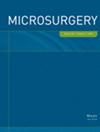Institutional protocols often mandate the use of x-rays when a microneedle is lost intraoperatively. Although x-rays can reliably show a macroneedle, the benefit of x-rays in detecting microneedles in human tissues has not been established as available data on this topic are investigated in anthropometric models. The current study aims to evaluate whether x-rays can reliably detect retained microneedles in a human cadaveric model. We hypothesize that microneedles would be detected at a significantly lower rate than macroneedles by x-ray in human tissues.
Needles ranging from 4-0 to 10-0 were placed randomly throughout a cadaveric hand and foot. Each tissue sample was x-rayed using a Fexitron X-Ray machine, taking both anteroposterior and lateral views. A total of six x-ray images were then evaluated by 11 radiologists, independently. The radiologists circled over the area where they visualized a needle. The accuracy of detecting macroneedles (size 4-0 to 7-0) was compared with that of microneedles (size 8-0 to 10-0) using a chi-square test.
The overall detection rate for the microneedles was significantly lower than the detection rate for macroneedles (13.5% vs 88.8%, p < .01). When subcategorized between the hand and the foot, the detection rate for microneedles was also significantly lower than the rate for macroneedles (hand: 7.6% for microneedles, 93.2% for macroneedles, p < .01; foot: 19.5% for microneedles, 84.4% for macroneedles, p < .01). The detection rate, in general, significantly decreased as the sizes of needles became smaller (7-0:70.5%, 8-0:18.2%, 9-0:16.7%, 10-0:2.3%, p < .01).
X-rays, while useful in detecting macroneedles, had a significantly lower rate of detecting microneedles in a cadaveric model. The routine use of x-rays for a lost microneedle may not be beneficial. Further investigation with fresh tissue and similar intraoperative x-ray systems is warranted to corroborate and support these findings.


